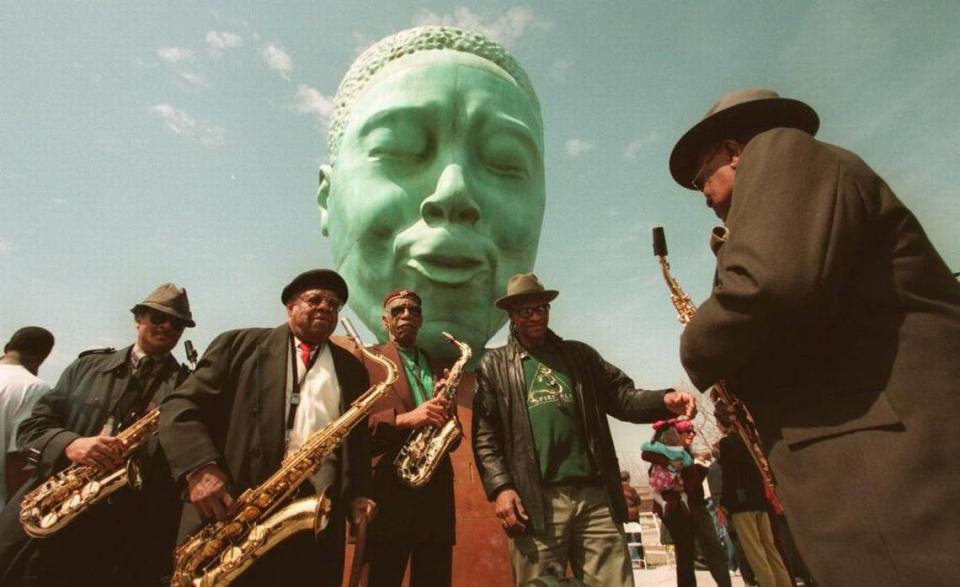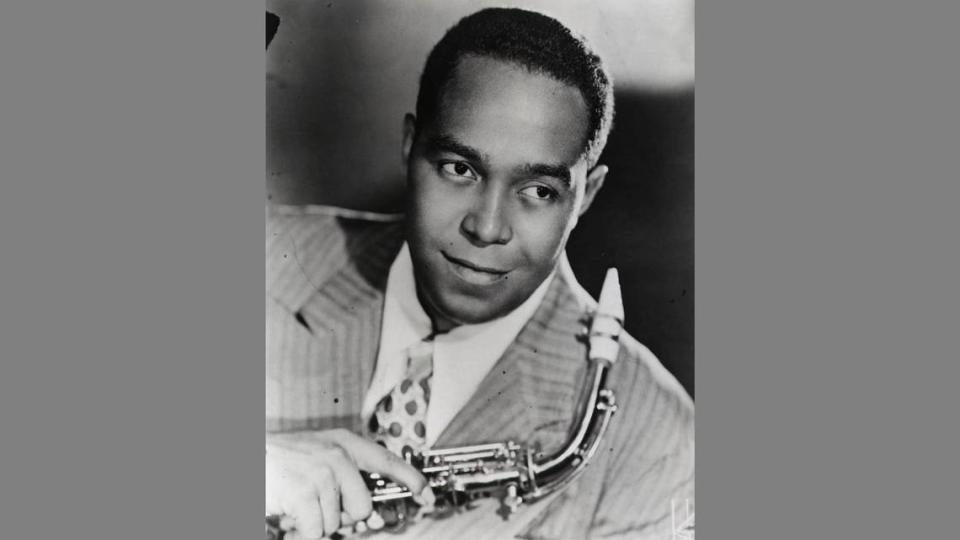Bronze Charlie Parker stood 20 years at 18th & Vine: So what’s the story behind it?
- Oops!Something went wrong.Please try again later.
Your Guide to KC: Star culture and identity writer J.M. Banks is acting as a tour guide of sorts to some well-known and hidden gems, with a focus on Kansas City’s communities of color. Send your ideas to jbanks@kcstar.com.
For decades the 18th and Vine Jazz District has been the centerpiece of artistic creativity in Kansas City’s Black community, so it makes perfect sense to find the sculptural depiction of one of the greatest figures to come out of this city’s early music scene sitting right in the middle of it.
“Bird Lives” was erected in March of 1999, commemorating Charlie “Bird” Parker, one of KC’s most influential music figures. It marked one of the first steps toward the rejuvenation of the historic jazz district.
The monument created by famed sculptor Robert Graham resides within the Charlie Parker Plaza, located at East 18th and Vine streets. The tribute stands 17 feet from base to top. The bronze statue faces east in the direction of the clubs Parker played in, and can be seen by motorists driving north along the Paseo Boulevard.
Dina Bennett, executive director for the American Jazz Museum, was in KC the summer after the unveiling of the sculpture and remembers the hope it instilled for the future of the district.
“It was just so fitting for this district, the place where Charlie Parker resided and traversed, lived near, hung out in the clubs and got the foundation for his musical genius,” said Bennett.
Bennett, a Topeka native, heard stories of the legendary 18th and Vine District from her father who was a musician. According to the stories, the metro’s cultural center was a stopping point for Black artists around the country hoping to make a name for themselves. For her, Charlie Parker was the embodiment of what it meant to be a musician at that time: someone completely dedicated to the craft and who impacted the community through the work.
Having previously worked at Black music museums like the B.B. King Museum & Delta Interpretive Center, in Indianola, Mississippi, and the National Museum of African American Music, in Nashville, Tennessee, Bennett has dedicated her career to educating the public on the impact of Black music in the American experience.
The “Bird” sculpture, with a green patina, features the head of Parker, with his eyes closed, his chin down and his lips pursed to a slight pucker, as if he is blowing into his saxophone.

Inscribed on the base of the statue are the words “Bird Lives.”
And here’s a tidbit that may be overlooked by many visiting the giant bust: The sculpture has a missing piece in the back of the head in the shape of the continent of Africa. The detail signifies the love Bird had for Black people, culture and history.
Parker, whose moniker “Bird” stemmed from his love of chicken or “yard bird,” was born in 1920 in Kansas City, Kansas, and spent his later years in the metro. Bird’s brilliance on the saxophone revolutionized improvisation and pushed jazz into another level of sophistication and style.
According to the Charlie Parker website, Parker cut his musical teeth hanging out in the alleyways behind the nightclubs that lined 12th Street in Kansas City, Missouri, where other jazz legends such as Count Basie, Lester Young, Mary Lou Williams and others engaged in marathon jam sessions.
As someone who has studied ethnomusicology, Bennett believes the contributions Parker made and his overall influence on jazz cannot be understated. Bennett thinks no one single figure in KC jazz has done as much as Bird and deserves to be immortalized on Vine Street more than him.
“Charlie Parker was one of our native sons and a co-creator of bebop with Dizzy Gillespie. I think they wanted to help keep his memory alive because this is the place that he crafted his musical accouterments,” she said.
Bird’s enduring influence has made him a legendary figure in the music diaspora. The statue is a great way to assure people never forget about the musical legacy this Kansas City artist left to the world.

Bennett says that she hopes that the district will see more statues and monuments arise there as a testament to greatness that the district has produced. The jazz district, she said, is always open to new ideas from artists looking to create something that adds to the Vine Street aesthetic.
“It emphasizes how important jazz is in Kansas City and how it is integrated into its history,” said Bennett. “They (the public) want to see us paying homage and respect to what came before us and that is what we are trying to do as a part of our mission to not only preserve the genre but to let people know Kansas City’s place in its history.”

